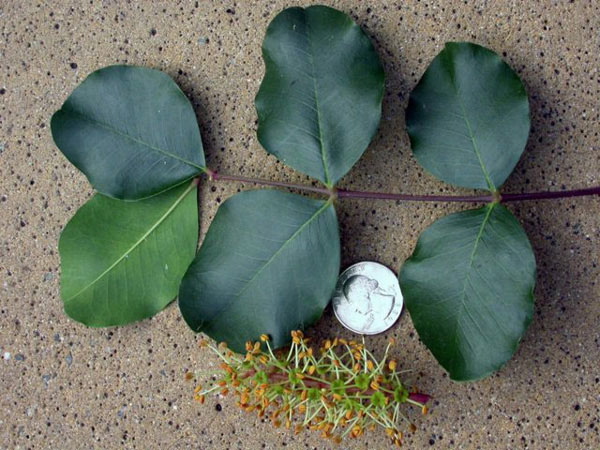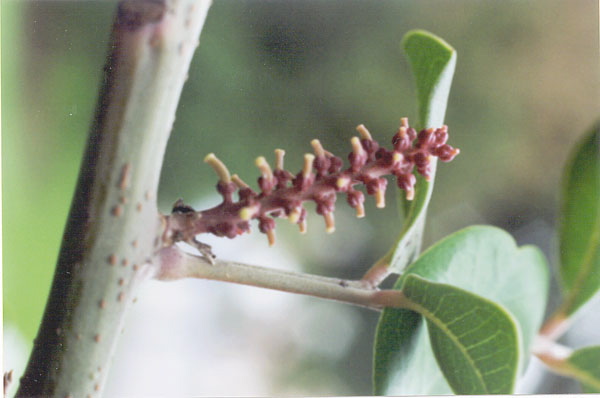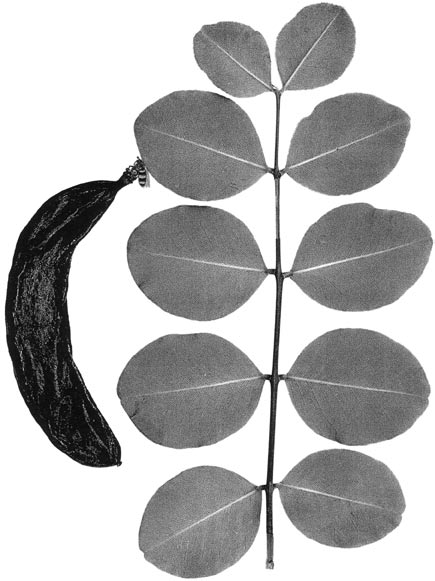Ceratonia siliqua
 carob, St. John’s bread
carob, St. John’s bread
A small to large tree with shiny, almost round, leathery pairs of leaflets about 2 inches in diameter. The flowers, which are without petals, occur in 2-inch racemes. The thick, flat pods, which are around 6 inches long, contain the edible flesh upon which St. John reputedly subsisted in the desert: locust beans, with a supplement of honey. They also sustained the prodigal son and the Duke of Wellington’s cavalry. Today the carob furnishes ingredients for popular beverages and a wide variety of food products.
The seeds, which weigh five to the gram or 144 to the ounce, were the carats carried by ancient goldsmiths in their purses. The barleycorn (⅓ inch) is still the unit for shoe sizes and double-spaced typing, having survived from days when biological standards of reproducibility (feet, cubits, paces) sufficed for weights and measures. Dimensions in old-fashioned botanical texts (e.g. A Manual of the Flowering Plants of California, W. L. Jepson, 1963) were often expressed in lines (half a barleycorn), while typesetters still routinely use the term pica, which is equal to one line. The siliqua was a small Roman weight equal, according to one author, to one or two chickpeas.
In 1973 there were five specimens on Galvez Street in the lawn southeast of Frost Amphitheater behind a group of honey locusts (Gleditsia triacanthos); only one of the trees had bread. By 2002 only two remained in what became a well-kept lawn south of Arrillaga Alumni Center, both males. In 2025, one remains. One tall and two small males are at 645 Salvatierra Street. One remains of a pair at the east end of the large Jordan Quad parking lot. The only central campus specimen which provides fruit is northwest of the Fire Station, in the parking lot. Two other females are at 1000 Welch Road, on the left, halfway down to the back of the lot.
Half a dozen ancestral seniors can be visited for a preview of the future on Curtis Street between Santa Cruz and Menlo avenues, Menlo Park, and there are more big ones lining Kipling Street between Lytton and University avenues, Palo Alto.
Gone are several in the entry parking lot at 1101 Welch Road, one outside the entrance to the Round Room at Memorial Church, and one in the lawn north of the Old Union, all removed around 2010–2014.
Fallen pods can be gathered under the female trees. Eat the pods whole, but be careful of the seeds, which are very hard. Sometimes desert trees do not like to be watered and abhor being placed in lawns. The eight carobs originally installed in the 1960s around the Claw fountain of Aristides Demetrios in the White Plaza pool promptly displayed their resentment of the lawn water by perishing.
Name derivation: Ceratonia – from the Greek keratonia (the name for Carob), derived from Greek keras (horn, alluding to the pods); siliqua – perhaps same etymology as silique (narrow elongated seed capsule). Carob: Middle English carabe, from Old French carobe, from Medieval Latin carrubium, from Arabic Harruba, carob pod.
About this Entry: The main text of this entry is from the book Trees of Stanford and Environs, by Ronald Bracewell, published 2005. All campus locations verified, removals noted (SP, Oct 2019). Three female locations on Stanford land added (Mar 2025, SP).






